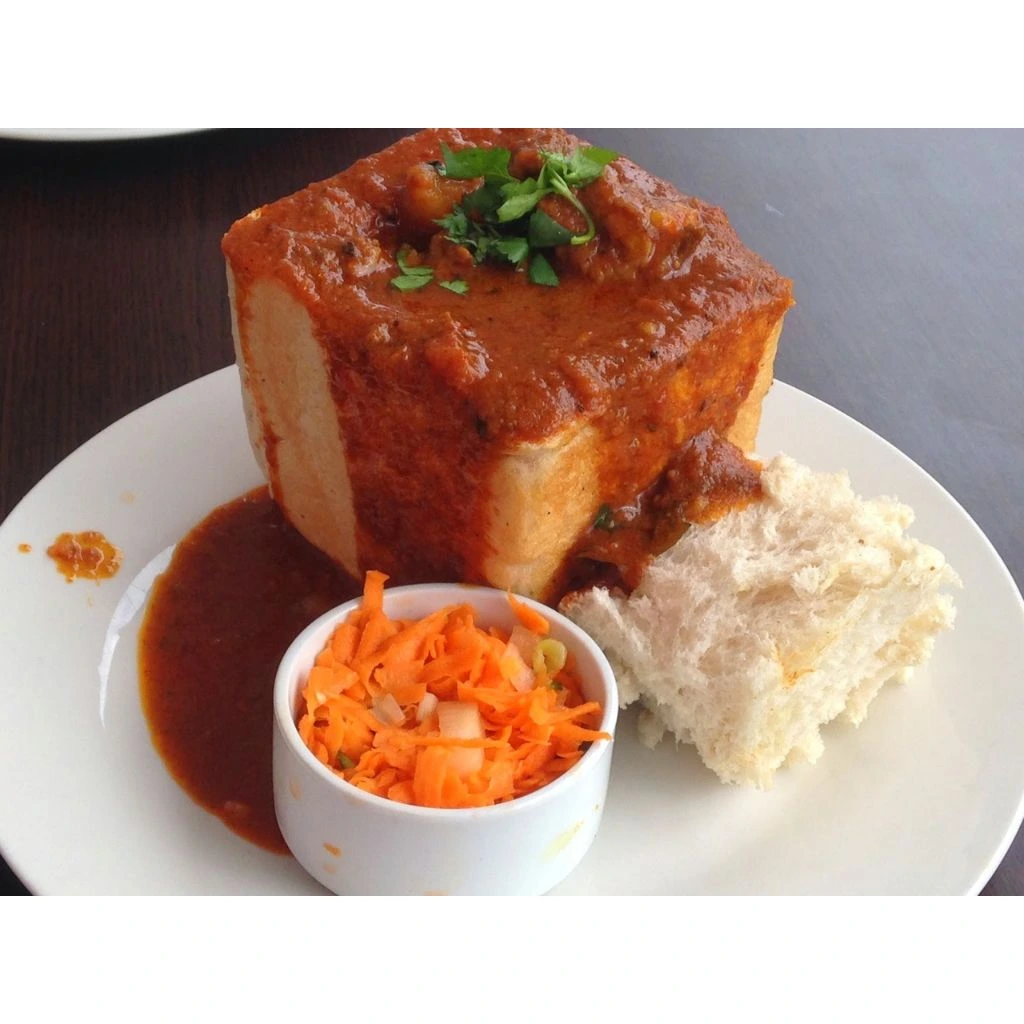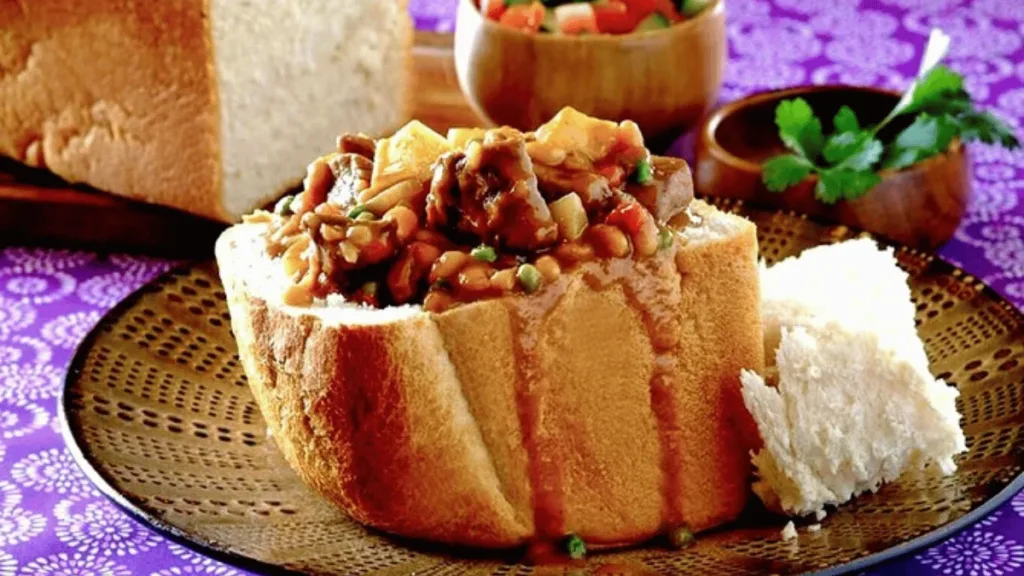Authentic Vegan Bunny Chow Recipe: South Africa

Introduction
Here’s your guide to your authentic vegan bunny chow recipe.
Have you ever wondered how South Africa’s favourite street food gained global fame?
Bunny chow is more than just food; it’s a cultural icon. It showcases the rich history of Durban’s lively Indian community!
They serve this famous dish in a hollow loaf of bread. It’s filled with flavorful curry and has won hearts everywhere.
Here’s the exciting part: you can have a truly authentic South African experience. Plus, it’s entirely plant-based and healthy!
Our vegan bunny chow recipe keeps all the amazing traditional flavours. It has fragrant spices, a rich curry base, and that comforting feel.
Plus, it doesn’t compromise your dietary values.
Ready to transform your kitchen into a Durban street corner? Let’s dive into this incredible cuisine.
What is Bunny Chow? Understanding South Africa’s Iconic Street Food
I’ll never forget the first time I heard about “bunny chow.” I was confused!

I thought of rabbit food right away. I couldn’t see why anyone would be excited about it.
Once I learned about this amazing South African street food, I became hooked. It’s a fascinating story, and incredible flavours captivated me.
Let me clear up the confusion right away: bunny chow has absolutely nothing to do with rabbits!
It’s one of South Africa’s favourite dishes – a hearty curry in a hollowed-out loaf of bread.
This clever dish shares a remarkable story of resilience, creativity, and cultural mix. It continues to charm food lovers worldwide.
The Fascinating Origins Story
The name “bunny chow” comes from “bania.” This term refers to Indian merchants and traders.
Over time, “bunny” emerged as a term. The story behind the word is as intriguing as the food!
This dish originated during South Africa’s apartheid era, particularly in the city of Durban. There, the Indian community had strict dining limits.
Here’s where it gets interesting: Indian families couldn’t dine in “whites only” restaurants.
So, they had to find clever takeaway options.
So, creative cooks started serving curry in hollowed-out bread loaves. This made portable, tasty containers that were both handy and yummy.
This was more than just convenience; it was a bold culinary move. It turned necessity into one of the world’s most unique street foods.
What Makes Bunny Chow So Special
When I tell friends about bunny chow, I say it’s “curry in a bread bowl.” But that doesn’t show its magic.
Imagine a quarter or half loaf of white bread. It’s hollowed out to hold a flavourful, spicy curry that makes your taste buds sing.
Moreover, nothing goes to waste!
The scooped-out bread acts as your “lid” and utensil. It’s like edible packaging that enhances the entire experience.
The bread soaks up the fantastic flavours of the Durban curry. It creates textures and tastes that cannot be matched with regular plates and cutlery.
Traditional bunny chow typically features specific curry types, such as mutton, chicken, or vegetables.
Each curry features its own South African spice blend. This adds rich, unforgettable flavours.
Cultural Significance and Global Impact
What truly resonates with me about bunny chow is its profound cultural significance.
This dish blends Indian cooking with South African flavours. It creates a unique taste that reflects the spirit of the Rainbow Nation.
Furthermore, it has become so integral to South African identity that locals often refer to it as their unofficial national dish.
Interestingly, bunny chow didn’t remain confined to South Africa’s borders. As communities travelled globally, they brought this incredible street food with them.
Consequently, you can now find authentic bunny chow restaurants in London, New York, Australia, and beyond.
Bunny chow is more than tasty food. It’s a slice of South African history. It showcases resilience and the power of excellent cuisine to unite people, regardless of their differences.
Making Bunny Chow Vegan: Plant-Based Protein Alternatives
I’ll be honest. When I first thought about making vegan bunny chow, I felt a bit nervous. I wanted to capture those rich, meaty flavours that make this South African street food so tasty.
After many kitchen experiments, I’m excited to say that plant-based bunny chow is amazing!
First, let me tell you about my go-to protein alternatives.
Lentils are, in fact, my secret weapon for vegan bunny chow recipes. Red lentils cook down nicely, giving a thick, hearty texture. Green lentils stay firm, adding a nice bite.
Additionally, chickpeas work wonderfully – I love mashing half of them for creaminess while keeping the rest whole.
Moreover, textured vegetable protein (TVP) has become my favourite discovery. Rehydrated with spiced vegetable broth, it surprisingly feels like traditional mutton.
Mushrooms, like king oyster or portobello, bring an umami depth that makes your taste buds sing.
What excites me is that these plant-based proteins absorb the flavours of Durban curry spices even better than meat!
Consequently, you get more intense flavours in every bite. I love mixing different proteins. For example, lentils go great with mushrooms. Chickpeas also pair well with TVP.
Additionally, tofu and tempeh work beautifully when marinated overnight in curry spices.
The key is to press out extra moisture first. Then, let those amazing South African flavours soak in thoroughly.
Making healthy vegan bunny chow isn’t about giving up; it’s about making informed choices. It’s about discovering new flavours of this beloved street food. We also honour its cultural roots!
Essential Spices for Authentic South African Curry Flavour
Getting the spice blend right is crucial to achieving authentic South African curry.
When I first tried making bunny chow at home, I used generic curry powder. It didn’t have that special Durban magic I was looking for.
Here’s what I’ve learned: traditional South African curry powder is the absolute foundation.
It usually includes coriander seeds, cumin, fennel, fenugreek, and turmeric as its base. This sets it apart from other curry blends.
Also, what makes it uniquely South African is the strong flavour of coriander. It’s usually the main taste.
Moreover, I always add garam masala for warmth and depth.
Additionally, fresh curry leaves are essential for achieving that authentic taste. Dried ones don’t measure up! I love using fresh ginger and garlic paste. They add amazing aromas.
Now, here’s my insider tip: toast your whole spices before grinding them. The difference is phenomenal!
Cardamom pods, cinnamon sticks, and bay leaves add depth to South African curry. These ingredients create the unique flavour that makes it special.
Most importantly, don’t forget the heat! Fresh chillies or chilli powder bring the authentic Durban fire. However, I always recommend starting mild and building up – you can add more spice, but you can’t take it away!
Trust me, investing in high-quality South African spices can completely transform your bunny chow!
Choosing the Perfect Bread for Your Vegan Bunny Chow
Choosing the right bread completely changed my bunny chow game! It’s crucial!
When I first tried making this South African street food at home, I used any loaf I could find. It turned out to be a disaster.
Traditionally, bunny chow is made with white bread. It’s strong enough to hold all that yummy curry without breaking apart.
However, I’ve discovered some fantastic healthy alternatives that work beautifully! Whole wheat bread is my favourite. It adds nutty flavours and offers more fibre and nutrients.
Moreover, the key is finding bread with a tight crumb structure.
Sourdough is excellent, and brioche offers a truly indulgent experience. It’s richer than the usual versions.
Additionally, I always look for unsliced loaves because you need substantial walls to contain that curry.
My key tip is this: when hollowing out the bread, keep at least an inch of wall thickness. Furthermore, I save those bread pieces as the “lid” – they’re perfect for scooping!
For those avoiding gluten, I’ve had great success with dense gluten-free sandwich loaves. The trick is choosing ones that won’t crumble under pressure.
Always use day-old bread. It’s firmer and holds its shape better than fresh bread when filled with hot curry!
Step-by-Step Vegan Bunny Chow Recipe
I’m thrilled to share my foolproof vegan bunny chow recipe with you!
I’ve perfected this South African street food classic in my kitchen.
This plant-based version now rivals any traditional one I’ve tried in Durban.
Ingredients You’ll Need
First, let me walk you through what you’ll need.
For the curry base, you’ll need:
- 1 cup red lentils.
- 1 can chickpeas (drained).
- 2 large onions (diced).
- 4 garlic cloves (minced).
- 1 inch fresh ginger (grated).
You’ll also need:
- 3 tablespoons South African curry powder.
- 1 teaspoon garam masala.
- 1 can diced tomatoes.
- 2 cups vegetable broth.
Moreover, don’t forget two fresh chillies, curry leaves, one bay leaf, coconut oil for cooking, and salt to taste. For serving, you’ll need two unsliced white or whole wheat loaves.
The Cooking Process
Now, here’s where the magic happens! First, heat the coconut oil in a large pot over medium heat. Add curry leaves next and let them sputter. This makes amazing-smelling oils. Next, add the onions and cook until they are golden brown, approximately 8-10 minutes.
Subsequently, add garlic, ginger, and chilli peppers, cooking for an additional 2 minutes. Furthermore, stir in curry powder and garam masala, letting those spices bloom for 30 seconds until fragrant.
Then, add the diced tomatoes and simmer until they are tender and broken down. Then, add lentils, chickpeas, bay leaf, and vegetable broth. Bring everything to a boil. After that, add the diced tomatoes and let them cook down until they are completely broken down.
Preparing Your Bread Bowl
Meanwhile, cut off the top quarter of your bread. Then, hollow out the inside, but leave the thick walls intact. Save those bread pieces – you’ll need them for dipping!
Bringing It All Together
Finally, taste and adjust seasoning as needed. The curry should be thick enough to stay in place in your bread bowl without becoming soggy immediately.
When ready to serve, fill each hollowed bread generously with the hot vegan curry. Put the bread “lid” on top. Now you have authentic vegan bunny chow, full of traditional South African flavours!
Trust me, this healthy plant-based version will have everyone asking for seconds.
The mix of well-spiced lentils and chickpeas offers a fantastic depth of flavour and satisfaction!
Healthy Modifications Without Compromising Taste
I used to think that making bunny chow healthier would mean losing the great South African flavours I love.
I’m excited to share my tasty vegan bunny chow! After numerous kitchen experiments, it turns out to be even better than the original.
First, let me talk about oil reduction.
I have noticed that using a lot of oil is not necessary when sautéing with water. Additionally, I add just a teaspoon of coconut oil at the end for that authentic richness.
This simple swap cuts calories significantly while maintaining all those gorgeous curry flavours.
Moreover, I love boosting the nutritional content by adding extra vegetables. Diced carrots, bell peppers, and spinach blend seamlessly into the curry base.
Furthermore, sweet potatoes create incredible creaminess while adding beta-carotene and fibre.
The best part?
These additions enhance the flavour complexity!
Here’s my favourite trick: I swap half the lentils for quinoa. This provides me with complete protein and added texture. Subsequently, this creates a more filling meal that keeps you satisfied longer.
I’ve found that using low-sodium vegetable broth helps. Adding natural flavours—like lemon juice, fresh herbs, and extra curry leaves—brings depth without using salt.
Furthermore, incorporating superfoods like chia seeds (they’re virtually unnoticeable when mixed in!) boosts omega-3s.
Choosing whole-grain bread over white bread is key. It adds fibre and B vitamins. It also maintains the structure of your rabbit’s food.
Believe me, these modifications to your health will make you feel terrific. You can enjoy every taste of this popular street dish from South Africa!
Storage, Reheating, and Meal Prep Tips
Honestly, learning to store and reheat bunny chow changed my meal prep game!
At first, I stored everything together. This resulted in soggy bread and disappointing leftovers.
However, I’ve now learned how to keep this South African street food fresh and tasty.
First, always store the curry and bread separately!
I keep the vegan curry in airtight containers in the refrigerator for up to 4 days. I also wrap the hollowed bread in plastic wrap or use bread bags. This helps keep it fresh.
This separation stops the bread from getting soggy. It also allows those amazing curry flavours to stand out.
Moreover, freezing works beautifully for meal prep!
The curry freezes exceptionally well for up to 3 months. I portion it into individual servings, which makes weekday meals incredibly convenient.
Furthermore, I label everything with dates because frozen curry can lose some spice intensity over time.
When I reheat, I have a secret. I add a little vegetable broth or coconut milk. This helps bring back the perfect consistency.
Also, reheating on medium heat helps avoid burning. Stir occasionally to maintain the ideal texture.
I lightly toast the bread in the oven for 2-3 minutes to crisp it again before serving. This creates a great contrast. The inside is warm and soft, while the outside is slightly crispy.
Always reheat food to 165°F for safety. This is especially important for plant-based proteins.
Trust me! Good storage and reheating keep your bunny chow tasting fresh and delicious.
Conclusion
Make an authentic vegan bunny chow and bring the lively streets of Durban to your kitchen!
This healthy, plant-based choice proves that you can honour tradition and eat well.
A blend of fragrant spices, filling plant proteins, and the iconic bread bowl creates a memorable meal.
The best bunny chow comes from love, patience, and respect for its rich culture.
Every bite links you to South Africa’s rich food story. It also nourishes your body with healthy, plant-based ingredients.
Want to wow your family and friends with a classic South African street food?
Gather your spices, choose your favourite plant protein, and let’s get cooking!
Don’t forget to share your bunny chow creations – I’d love to hear how your vegan version turns out.
